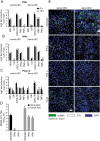Establishment of well-differentiated camelid airway cultures to study Middle East respiratory syndrome coronavirus
- PMID: 35725865
- PMCID: PMC9208254
- DOI: 10.1038/s41598-022-13777-y
Establishment of well-differentiated camelid airway cultures to study Middle East respiratory syndrome coronavirus
Abstract
In 2012, Middle East respiratory syndrome coronavirus (MERS-CoV) emerged in Saudi Arabia and was mostly associated with severe respiratory illness in humans. Dromedary camels are the zoonotic reservoir for MERS-CoV. To investigate the biology of MERS-CoV in camelids, we developed a well-differentiated airway epithelial cell (AEC) culture model for Llama glama and Camelus bactrianus. Histological characterization revealed progressive epithelial cellular differentiation with well-resemblance to autologous ex vivo tissues. We demonstrate that MERS-CoV displays a divergent cell tropism and replication kinetics profile in both AEC models. Furthermore, we observed that in the camelid AEC models MERS-CoV replication can be inhibited by both type I and III interferons (IFNs). In conclusion, we successfully established camelid AEC cultures that recapitulate the in vivo airway epithelium and reflect MERS-CoV infection in vivo. In combination with human AEC cultures, this system allows detailed characterization of the molecular basis of MERS-CoV cross-species transmission in respiratory epithelium.
© 2022. The Author(s).
Conflict of interest statement
The authors declare no competing interests.
Figures



References
-
- WHO. EMRO | MERS outbreaks | MERS-CoV | Health Topics. http://www.emro.who.int/health-topics/mers-cov/mers-outbreaks.html (Accessed 19 October 2021).

